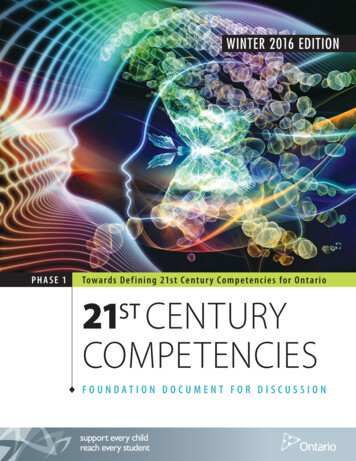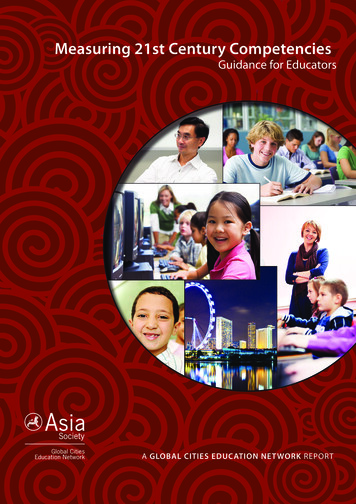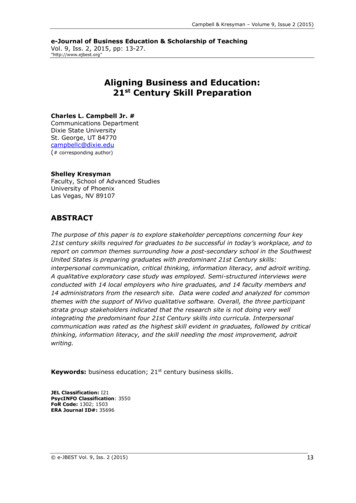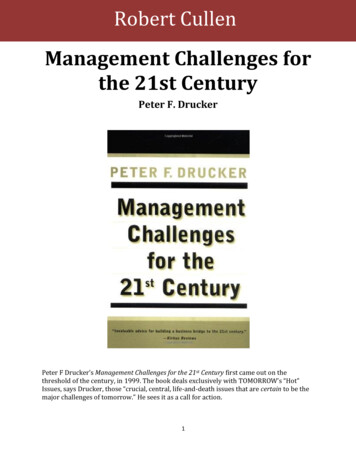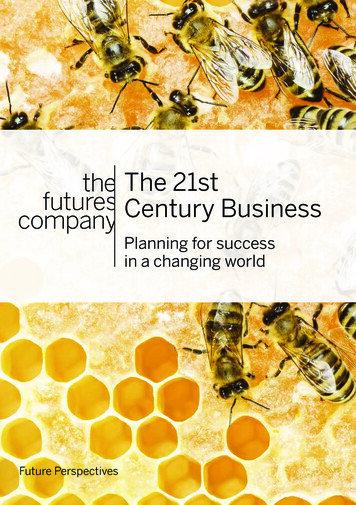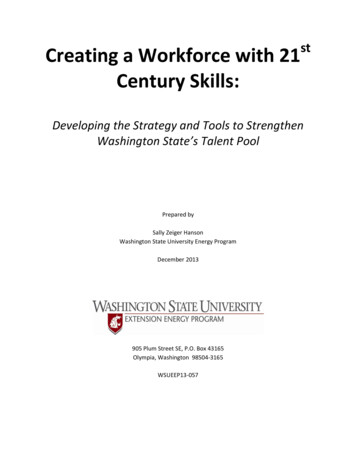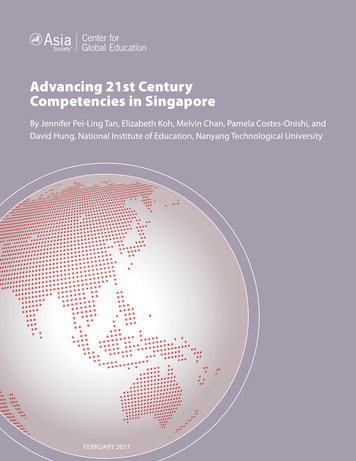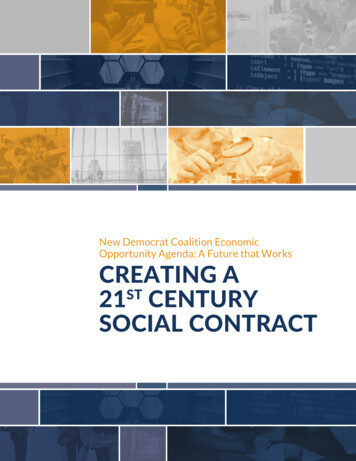
Transcription
New Democrat Coalition EconomicOpportunity Agenda: A Future that WorksCREATING A21ST CENTURYSOCIAL CONTRACT
New Democrat Coalition Economic Opportunity Agenda: A Future that WorksCreating a 21St Century Social ContractCredit: Library of Congress, Prints & Photographs Division, LC-USW33-028624-CSocial contractGenerations of advocates, policymakers, and thought leaders have fought for theThe social contractbenefits, worker protections and social safety net enjoyed by most working Americans.includes the employerbased benefits systemand the governmentbased safety netAdvances made during the Great Depression and post-World War II eras, and thesocial contract that was established at that time, made our workforce the envy ofthe world. As American GIs returned home to enter the workforce, the nation madeprograms that surroundunprecedented investments in the skills of our people through policies such as theworkers. It representsGI Bill, expanding upon the social contract created during the Great Depression.the relationship andThis turned America into an economic super power of shared prosperity that builtresponsibilities betweena strong middle class. For reasons that made economic sense at the time, that socialthe private sector andpublic sector and theAmerican worker.contract was mainly offered through an unofficial public-private partnership betweenthe government and employers. The government incentivized companies to offerbenefits to their employees, and, in turn, provided a safety net to those workers whoTraditional full-timeworkersfell out of the workforce.Those who have a directOur goal has always been, and must remain, to protect and advance the interests of theemployer-employeeAmerican worker. Prior generations designed our safety net and benefits system forwork arrangement.a traditional full-time worker who spends their career with one employer. However,These workers generallyin recent decades, relentless attacks on organized labor and the disruption of work byhave access to employersponsored healthglobalization and technology has accelerated changing dynamics between workersinsurance, retirementbenefits, paid leave, andother benefits.1
New Democrat Coalition Economic Opportunity Agenda: A Future that WorksCreating a 21St Century Social ContractBenefitsand companies, and given rise to alternative work.1 American workers now live in twoGenerally refer todifferent worlds: many still enjoy the stability of the 20th century social contract, whilethe employer-baseda growing number of workers find themselves left out of employment protections,benefit system,benefits, and the financial security that comes with them.including employersponsored groupAmerican workers now live in two different worlds: manyhealth insurance plans,retirement savings,still enjoy the stability of the 20th century social contract,paid time off, workers’compensation, andwhile a growing number of workers find themselves leftothers. The relationshipout of employment protections, benefits, and the financialand responsibilitiessecurity that comes with them.between the privatesector and publicsector and theAmerican worker.AlternativeworkersThe New Democrat Coalition (NDC) believes all workers should have the opportunityto earn a good life. Unfortunately, many laws and regulations governing the employeeemployer relationship are in need of updates. As workers change jobs or industriesThose who workdue to disruption, hold multiple jobs at once, or work in alternative arrangements,through alternativelegacy employer-provided benefits and protections may no longer meet their needs.arrangements,The New Democrat Coalition supports updating the social contract by creating an optionmeaning they arenot employees of thecompanies for whichof portable benefits, modernizing the worker safety net, and expanding eligibility forthese protections and programs. Doing so would give more American workers financialthey directly work.security, and help unleash the independence, innovation, and economic potential ofClick here and here toour workforce.learn about the varioustypes of alternativework arrangements.Creating an option of portable benefits, modernizing theSafety networker safety net, and expanding eligibility would giveRefers to governmentmore American workers financial security, and help unleashsponsored supportprograms and workerthe independence, innovation, and economic potential ofprotections, includingour workforce.social security,worker displacementassistance, and laborprotections likeantidiscriminationprovisions.21.Note: Alternative workers as defined by the Bureau of Labor Statistics (BLS) make up just 10 percent of the totalworking population as of May 2017. Economists generally argue this figure is likely lower than reality due to thesubjective nature of the questions, and because the BLS data only measures primary alternative work. For example,Katz and Krueger estimated alternative workers made up 15.8 percent of all workers in 2015, and the University ofChicago’s General Social Survey (GSS) found that 20.3 percent of workers had independent arrangements. Whenmeasuring for non-primary alternative work, the Federal Reserve Bank of New York found that roughly 34 percentof U.S. adults engage in alternative work.
New Democrat Coalition Economic Opportunity Agenda: A Future that WorksCreating a 21St Century Social ContractT O D A Y ’ S W O RK LANDSCAPEWhile the vast majority of workers operate within the traditional employer-employeesystem, today’s workers are increasingly on their own either by choice or circumstance2as more jobs are becoming short-term, project-based and temporary. The alternativeworkforce—including independent contractors, on-call workers, temporary help agencyworkers, workers provided by contract firms, gig economy workers, and contingentworkers—has grown in recent decades.3 The Bureau of Labor and Statistics’ (BLS)recent Contingent Worker Supplement (CWS) found that the portion of the Americanworkforce engaged in alternative work as primary employment has remained relativelyconstant over the last two decades.4 However, the growth of alternative work can alsobe measured by those who may have primary traditional employment and engage in2.Cornell University ILR School and The Aspen Institute Future of Work Initiative, (2018) “What are the experiencesof gig workers?”, Gig Economy Data Hub3.Cornell University ILR School and The Aspen Institute Future of Work Initiative, (2018) “How many gig workersare there?”, Gig Economy Data Hub4.Bureau of Labor Statistics (2018), “Contingent and Alternative Employment Arrangements”, U.S. Departmentof Labor3
New Democrat Coalition Economic Opportunity Agenda: A Future that WorksCreating a 21St Century Social ContractAbove: Shambaugh, Jay; Nunn, Ryan; Bauer, Lauren (2018) “Independent Workers and the Modern Labor Market”, The HamiltonProject, Brookings Institutionthe alternative workforce to supplement their income.5 The population of workersoperating outside of traditional full-time employment grows even more when inclusiveof standard part-time workers6 who, like alternative workers, sometimes must piecetogether multiple part-time jobs to string together a full-time income.7Our goal has always been, and must remain, to protect andadvance the American worker.The trend toward alternative and part-time work has several causes, including:workers embracing the independence alternative work provides to monetize unused45.Bracha, Anat and Burke, Mary A. (2018), “Wage Inflation and Informal Work”, Federal Reserve Bank of Boston6.Jeszeck, Charles A. (2015), “Contingent Workforce: Size, Characteristics, Earnings, and Benefits”, U.S. GovernmentAccountability Office Note: The GAO report found that, based on their analysis of 2010 GSS data, 40.4 percentof the workforce operates outside of traditional employment structures. This includes both alternative workers,standard part-time workers, and self-employed workers not self-identified as independent contractors.7.Swanson, Ana (2016), “Who gets hurt when part-time work becomes the new normal”, The Washington Post;Golden, Lonnie (2016), “Still falling short on hours and pay” Economic Policy Institute
New Democrat Coalition Economic Opportunity Agenda: A Future that WorksCreating a 21St Century Social ContractIRS Data on Nonstandard Work Filings over TimeSource: Dourado and Koopman (2015) using IRS data.Note: Form 1099-MISC is used to report income received outsidetraditional employment relationships, such as from Uber, TaskRabbit, andAirbnb.Source: Katz and Krueger (2016) using IRS data.Note: Schedule C (Form 1040) is used to report earnings or lossesfrom operating business or practicing a profession as a soleproprietor.Above: Bracha, Anat and Burke, Mary A. (2018), “Wage Inflation and Informal Work”, Federal Reserve Bank of Bostontime, space, and labor; workers turning toward alternative work as a flexible way tosupplement income or because they cannot find traditional work; or due to fissuringof the workplace, in which some firms intentionally misclassify workers or replacefull-time employees with alternative and part-time workers, sometimes to avoidthe costs of employer-based benefits. Our goal has always been, and must remain,to protect and advance the interests of the American worker.The employer-employee relationship extends beyond salary and job responsibility.Employment status determines eligibility for employer-sponsored benefits, workerprotections and access to government support programs often referred to as thesafety net. Our benefits and safety net laws and regulations favor work arrangementsthat are traditional full-time arrangements. Traditional full-time workers make upthe majority of the overall workforce8 and are more likely than other workers to haveaccess to employer-sponsored benefits like health insurance and retirement savings,protection from workplace discrimination and harassment, and safety net programssuch as unemployment insurance or worker displacement assistance.8.Bureau of Labor Statistics, (2018) “Contingent and Alternative Employment Arrangements” Table 5, U.S.Department of Labor. Note: Many economists believe the latest BLS data underrepresents the alternative workerpopulation. Several members of the New Democrat Coalition have advocated for better funding, more frequentsurveying, and improved and expanded questions to better measure alternative work.5
New Democrat Coalition Economic Opportunity Agenda: A Future that WorksCreating a 21St Century Social ContractThe 20th century social contract is not serving the non-traditionalworker populationBecause alternative workers are not employees of the companies where they work(ex: independent contractors and temporary workers), our current system excludesthem from many protections and benefits designed for and afforded to direct full-timeemployees. Offering access to employer-sponsored benefits to certain alternativeworkers could trigger a reclassification as an employee. Fearful of inviting litigation,and sometimes reluctant to make the additional investments in their workforces,companies have instead opted to refrain from offering most alternative workers accessto, or substitutes for, company sponsored benefits, such as retirement savings, healthinsurance, and job protected leave.Part-time workers often face the same challenges as these alternative workers.While part-time workers who have a direct employment relationship with a firm canoften access benefits and the social safety net, many of the mandated protections, suchas those in the Family Medical Leave Act (FMLA) and the Affordable Care Act (ACA),depend on the number of hours worked by an employee. For example, a company isnot required to offer health insurance to a part-time employee who works fewer than30 hours per week. We must work to ensure that workers not covered by the currentsystem are not being left out or left behind.Our employee benefit system still reflects a post-World War II era where people workfor one company their whole lives and receive full benefits from that company whenour workforce no longer reflects that reality. For example, the federal governmentspends 260 billion per year subsidizing employer-sponsored health insurancethrough the exclusion of employer’s contributions from taxable income with no analogfor alternative or part-time workers who have limited or no access to employerprovided insurance.9 The Affordable Care Act created health insurance exchanges tooffer insurance to those left behind by our employer-based system, and one in fiveparticipants in ACA health insurance exchanges are small business owners or selfemployed.10 The ACA extended affordable coverage to millions of Americans, anddespite that advancement, as well as the need to support other workers excluded fromthe employer-sponsored health insurance, Republicans in Congress have continued toattack and undermine the ACA, which has kept it from truly serving as a platform forportability, access, and affordability.9.Congressional Budget Office, (2013), “The Distribution of Major Tax Expenditures in the Individual IncomeTax System”, U.S. Congress10. Reder, Libby; Foster, Natalie (2017) “Health insurance portability key for independent workers’ access tocoverage”, The Aspen Institute6
New Democrat Coalition Economic Opportunity Agenda: A Future that WorksCreating a 21St Century Social ContractThe uneven treatment of our workers is not limited to healthcare. Among the manybenefits traditional full-time workers generally enjoy, and alternative and part-timeworkers have significantly less access to, are also: retirement savings, paid and unpaidleave, worker’s compensation, and education and training. This disparity of accessextends to our government-sponsored social safety net. Alternative and standardpart-time workers have limited or no access to unemployment insurance, workerdisplacement assistance, and certain labor and wage protections. See Appendix A formore details on how different types of workers access the social contract.Today’s policymakers must step into the breach to give everyAmerican the opportunity to succeed.For some workers, third-party organizations facilitate access to benefits andother protections that traditional workers are offered through employers and thegovernment.11 The Freelancers Union, for example, provides many independentworkers the opportunity for members to purchase benefits and protections providedthrough the union. By opting-in, these workers have access to negotiated benefits,such as medical, disability, and term life insurance. Other unions and guilds, like thosefor TV or movie production and construction workers who tend to have project-basedwork, serve a similar function for their membership. They offer benefits at a negotiatedrate; however, unlike the Freelancers Union, the guilds and unions receive pro-ratedbenefits contributions on behalf of workers from the companies at which they work.Additionally, New York State passed a statute in 1999 to establish the Black Car Fund(BCF), which is funded through a surcharge on consumers and provides and administersworkers compensation insurance, as well as vision and telemedicine benefits. Recentlythrough efforts to the Independent Drivers Guild, drivers for ride sharing companiesreceived access to benefits offered through the BCF. While these efforts deservecommendation and further exploration, they also vividly demonstrate the glaring lackof momentum amongst policymakers to address the looming crisis at a national level.Today’s policymakers must step into the breach to give every American the opportunityto succeed.11. Reder, Libby; Foster, Natalie; Nelson, Greg (2016), “Portable Benefits Resource Guide”, The Aspen Institute Futureof Work Initiative7
New Democrat Coalition Economic Opportunity Agenda: A Future that WorksCreating a 21St Century Social ContractP R I N C I P L ES FO R CRE ATING A 2 1 ST CENTURYS O C I A L C ONTRACT THAT WO RK S FO RT H E F U T UREThe New Democrat Coalition believes our benefits and safety net structures shouldchange to meet the needs of the 21st century workforce. All workers should havecertainty and security, and all companies should be able to provide benefits to thosewho do work for them. Because the provision of our benefits and safety net systemsexist through a partnership with the private sector, efforts to modernize the systemsshould maintain the expectations and requirements of the private sector to provide orcontribute towards these systems. To achieve that, we need a modern social contractfor the 21st century.All workers should have certainty and security, and allcompanies should be able to provide benefits to those whodo work for them.8
New Democrat Coalition Economic Opportunity Agenda: A Future that WorksCreating a 21St Century Social ContractWe suggest three overall principles for a new social contract:I. Universal: All workers should have access to benefits and safety net programs.Employers are still expected to participate in the system and should receiveequitable treatment from the government for providing all workers with benefitsregardless of the means of provision, whether directly through employersponsored benefits or indirectly through stipends given to workers to acquirebenefits independently. We should maintain what works in the existing employerand multiemployer-based benefits models while making modifications to meetthe shifting landscape of the changing economy and workforce. Furthermore,all workers, regardless of classification, should receive basic protections andaccess to the safety net.II. Portable: All workers should have the choice to access worker benefits,protections, and the safety net untethered from employers to provide portability,security and mobility. Workers should maintain continuous access to the sametype of benefits regardless of where and when they work. A new system shouldenable companies to make pro-rated contributions on behalf of workers, basedon the amount of work they do with that company, and in a way that does notreduce the responsibility companies currently have to provide benefits.III. Innovative: All workers will benefit from innovation in the benefits system andsafety net. We must expand access to and modernize the foundation of thesocial contract by rethinking how the safety net and benefits support all workerstoday and in the future. We should also promote innovation by local and stategovernments as well as other non-governmental organizations with a goal ofscaling what works.All workers, regardless of how they work, should have accessto benefits and safety net programs.9
New Democrat Coalition Economic Opportunity Agenda: A Future that WorksCreating a 21St Century Social ContractP O L I C Y R ECO MMENDATIO NSIn the realm of public policy, maintaining the status quo often wins out as it offers thepath of least resistance. When dealing with the challenges faced by American workersin the 21st century, however, maintaining the status quo is leaving many people behind.The times are changing, and we must change with them. Like a shark, if we are notmoving forward, we are slowly dying.To effectively serve the 21st century worker, the privatesector and government must come together to modernizethe entire social contract.We must modernize not only our benefits system, which exists largely within a privatesector infrastructure, but also the government-sponsored social safety net, which doesnot reach the needs of all Americans workers. To effectively serve the 21st century10
New Democrat Coalition Economic Opportunity Agenda: A Future that WorksCreating a 21St Century Social Contractworker, the private sector and government must come together to modernize the entiresocial contract. To ensure that we have a social contract that works for the future, theNew Democrat Coalition recommends exploring the following policies:Support innovation and experimentationA national effort to provide a 21st century social contract to workers will take time todevelop and fully implement. In the interim, federal policymakers should empowerinnovation and experimentation at lower levels of government and in the private sectorwho can act more quickly and take risks. Doing so will fill a void that currently exists anddevelop options policymakers could scale nationally.Fund innovative portable benefit pilots: Congress should establish and seed aportable benefits pilot grant fund at the Department of Labor to help fund the design,implementation and evaluation of new and existing models and approaches to provideportable benefits. Through a competitive grant program, state, local, and non-profitorganizations can experiment with innovative ways to reach more workers left out ofthe current benefits model. Senator Mark Warner and NDC Vice Chairwoman SuzanDelBene led a group of NDC Members to introduce the Portable Benefits for IndependentWorkers Pilot Program Act, bicameral legislation to establish the fund to providesuch grants.Support private sector and non-profit innovation: Like the Freelancers Union, manyprivate sector entities are filling the void of government inaction. Congress shouldsupport these efforts. Where appropriate, the federal government should grant alimited safe harbor from worker misclassification liability to entities who providebenefits or contributions toward benefits to non-traditional workers not classifiedas employees.Health insurance, retirement savings, training, paid leave,and workers compensation, among others, are core benefitsthat make up the social contract that enables workers to livethe American Dream.Develop benefit models that work for all workersBuilding on the innovation and experimentation occurring in the private sector and localand state governments, federal policymakers should take steps to design a benefitssystem that works for all workers. Health insurance, retirement savings, training, paid11
New Democrat Coalition Economic Opportunity Agenda: A Future that WorksCreating a 21St Century Social Contractleave, and workers compensation, among others, are core benefits that make up thesocial contract that enables workers to live the American Dream. In developing a 21stcentury social contract, benefits systems and the social safety net should be availableto workers regardless of their work arrangement.Create parity for workers and companies in the benefits system: In developing a21st century social contract, all workers should have access to benefits—includingretirement savings, healthcare insurance, and disability insurance—either directlythrough employer-sponsored plans or through portable benefits systems. Employercontributions to worker-controlled accounts for both traditional and alternativeworkers should be treated as another form of direct, tax-preferred compensation andnot trigger changes in worker classification. Similarly, were companies to give accessto their employer-sponsored group plans to certain alternative workers, this benefitshould not trigger changes in worker classification. Furthermore, federal policy shouldprovide equal tax preferences for providing benefits to workers regardless of howthey choose to access these crucial benefits. To have benefits be truly portable, weeventually should allow all workers—traditional full-time, part-time, and alternative—to choose their benefits plans and how and where they are managed.The Affordable Care Act established the first federally supportedsystem of privately administered portable benefits.Turn the Affordable Care Act health insurance exchanges into a portable benefitsmodel of excellence: Every American should have access to affordable health insurancefor themselves and their families. Passage of the Affordable Care Act establishedthe first federally supported system of privately administered portable benefits.The ACA created state-based exchanges where consumers and small businesses shopfor and purchase health insurance. Small businesses that use the ACA exchanges(Small Business Health Options Program or SHOP exchanges) can make tax-exemptpremium contributions on behalf of their employees just as they would for employersponsored plans.12 The ACA should be the foundation for a truly portable system forworkers and other Americans to receive health insurance benefits.Stabilize and expand upon the ACA to achieve universal coverage: Unfortunately, sincethe ACA's passage, Congressional Republicans and now the Trump Administration12. “Overview of SHOP: Health insurance for small businesses”, HealthCare.gov12
New Democrat Coalition Economic Opportunity Agenda: A Future that WorksCreating a 21St Century Social ContractHealthReimbursementAccounts (HRAs)Employer-fundedaccounts fromwhich employees arehave sabotaged the implementation of the ACA, driving up costs and limitingaccess. Congress should take immediate action to stabilize and improve the ACAalong the lines of the proposals outlined by the New Democrat Coalition in ourJuly 2017 Solutions Over Politics plan. As Congress seeks to stabilize the ACA, itshould also focus on expanding the number of quality coverage options consumersreimbursed tax-freecan access through the ACA markets, including the individual and small businessfor qualified medicalSHOP exchanges. Expanding market coverage is one important way to increaseexpenses up to a fixedmarket competition and lower premium costs. Auto-enrolling individualsdollar amount pereligible for premium assistance or Medicaid, creating more affordable plans foryear. Unused amountsindividuals with low usage of care, and streamlining enrollment periods to increasemay be rolled over tobe used in subsequentyears. The employerparticipation will also improve access and affordability. NDC Health Care TaskForce Co-Chairman Ami Bera introduced three bills to strengthen the ACA andfunds and owns themove towards universal coverage: the Pathway to Universal Coverage Act, theaccount.Modernize Health Savings Act, and the Easy Enrollment Act.Qualified smallbusiness healthreimbursementarrangements(QSEHRAs)Create portable health insurance accounts: Building on the model of qualified smallemployer health reimbursement arrangements (QSEHRAs), Congress shouldestablish portable health insurance accounts (PHIA) for workers who currentlydo not receive health insurance through work. Through a PHIA, workers wouldCan be used forreceive tax-exempt contributions from companies or other sources of incomequalified out of pocketto put toward towards purchasing health insurance on an ACA exchange. Whilemedical expenses,maintaining overall employer requirements under the ACA, contributions should beincluding healthencouraged where they are not currently required. For example, small companiesinsurance premiums forthat are currently exempt from the ACA employer mandate, or part-time andnon-employer-basedplans. The 21st CenturyCures Act signed intoalternative workers who do not count as full-time employees under the law. Further,to promote true portability of health insurance and consistent coverage as workerslaw in Decemberchange jobs, we should explore how we could eventually expand this model, while2016 allows for smallminimizing adverse selection, to provide workers eligible for employer-sponsoredbusinesses to use HRAshealth insurance with the option to apply their employer’s full existing contributionto fund employeesto a PHIA in lieu of participation in an employer’s plan.who purchase healthinsurance on thePromote the ACA for gap coverage: When workers leave a company that providesindividual market.employer-sponsored health insurance, the company is only required to informthem of their Consolidated Omnibus Budget Reconciliation Act (COBRA) eligibility,which allows workers to extend their health insurance coverage by purchasing theplan at full price. Congress should require companies to also inform workers thatthey qualify for a special enrollment period to acquire insurance coverage throughthe ACA exchange, which in many cases may be cheaper than a COBRA plan.NDC Rep. Brad Schneider introduced the Common SENSE Act to achieve this.13
New Democrat Coalition Economic Opportunity Agenda: A Future that WorksCreating a 21St Century Social ContractIn addition to keeping our commitments to workers whohave paid into the Social Security system, every workershould have a savings vehicle to help provide financialsecurity in retirement.Give all workers access to retirement savings: The current retirement savings systemis not working for all Americans. Millions of Americans are unable to properly preparefor retirement. America’s current retirement savings system is complex, reliant onemployers, and leaves out many working Americans. While employer-sponsored plansare a good option for those covered, not every company offers one and part-time andalternative workers often do not have access to these plans. In addition to keepingour commitments to workers who have paid into the Social Security system, everyworker should have a savings vehicle to help provide financial security in retirement.Unfortunately, moreover, the current system makes companies, most lacking ininvestment expertise, liable for the management of their employees’ savings. This canbe burdensome and costly for employers, discouraging some from offering retirementaccounts. We need improvements to the system to offer more options to workers toretire with dignity and security.Make it easier for more employers to provide retirement savings vehicles to workers:While the current 401(k) system works well for employees of large and establishedbusinesses, most people who work for small businesses have significantly less accessto retirement savings due to the cost and liability of running a small business plan.Changes to federal law can expand access for more workers to the employer-basedretirement savings system and allow companies to encourage more savings by
New Democrat Coalition Economic Opportunity Agenda: A Future that Works reating a t entury ocial ontract 2 and companies, and given rise to alternative work.1 American workers now live in two different worlds: many still enjoy the stability of the 20th century social contract, while a growing number of workers find themselves left out of employment protections,



